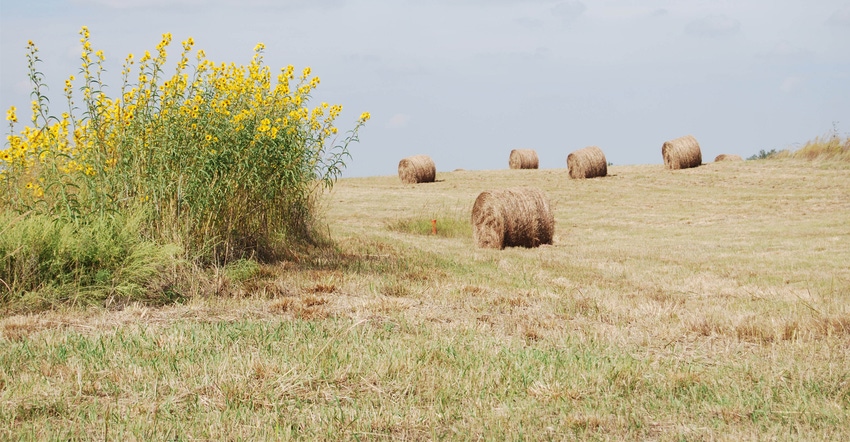October 10, 2018

By Ben Beckman and Mariah Woolsoncroft
With this year's wet weather, many producers put up hay much later in the season than normal. A late harvest date means grasses have already produced seed heads and are rapidly declining in forage nutrient value.
While having low-quality hay on hand for winter feed is better than none, producers will need to consider the challenges of meeting cattle nutrient requirements this winter.
During a normal year, hay harvest starts in late June or early July when quality is generally higher at over 10% crude protein (CP) and less than 50% total digestible nutrients (TDN).
The higher quality is due to a higher leaf-to-stem ratio, as leaves are higher in protein and energy. A delay in cutting and harvesting until late July or August can have a negative impact on quality. Stems and seed heads are lower in protein and energy, so as grasses mature later into the season forage quality declines.
For many this year, haying season was delayed into August or even September, when grasses are "stemmy" and fully matured. Further impacting hay quality was the exceptional rainfall itself. In wet years, forages tend to grow more rapidly and mature quicker, which may decrease overall forage quality and require additional supplementation to meet cow nutrient requirements.
It's important to react to a cow’s changing nutrient requirements, such as lactation or stage of gestation. For example, a 1,200-pound gestating cow may need 1.5 pounds CP daily in her diet to maintain body condition, compared to a 1,200-pound lactating cow, which may need 3 pounds CP per day.
The crude protein requirements will vary for each animal depending on a cow’s weight and pounds of milk produced. It's also important to understand cow weights and milk production in a herd for a producer to balance nutrient requirements without over- or underfeeding.
With most management decisions, the more information available to plan, the better outcome that can be achieved. For a livestock producer, that would include having harvested feed analyzed. Sample hay according to lots, typically less than 100 tons of hay that is grouped by bales of the same forage type, harvested in the same area and harvested at a similar time.
Take multiple samples per lot (15 to 20 round bales should be adequate) and use a mechanical probe to core and collect a sample (15 to 20 cores). Detailed instructions on how to properly sample hay can be found in the Sampling Feeds for Analysis, NebGuide G331.
Protein supplementation
If available forage or harvested feedstuff does not meet the protein needs of the animal, supplementing protein from other sources is the next step. Common methods many producers use to provide protein include lick tubs and range cubes.
Alternative feedstuffs can be used to meet protein needs and may be a more cost-effective option if proper storage sites and feeding equipment are available. Examples include dried distillers grain, cottonseed meal, sunflower meal and canola meal. To decrease supplemental costs, producers should price supplements on a dollars per pound of CP basis, rather than a dollars per ton basis.
For those wanting more information on balancing low-quality hay and protein supplementation options, workshops on "Feeding Your Cows With Low Quality Hay" will be held in north-central and northeast Nebraska this fall:
• Nov. 19 — Fullerton; 5:30 to 8:30 p.m.; contact: Mariah Woolsoncroft 308-536-2691
• Dec. 4 — Hartington; 5:30 to 8:30 p.m.; contact: Ben Beckman 402-254-6821
• Dec. 6 — Brewster; 11 a.m. to 2 p.m. CT; contact: Bethany Johnson 308-645-2267 or [email protected]
Workshops will cost $15 per person with a ranch discount of $10 per person for groups of three or more. Attendees are encouraged to bring in their own feed or hay analysis to discuss and interpret. A meal will be provided, and participants are asked to RSVP one week prior.
Beckman and Woolsoncroft are Nebraska Extension educators. This report comes from UNL BeefWatch.
You May Also Like




